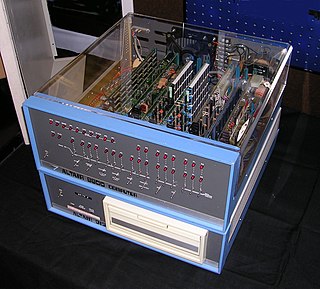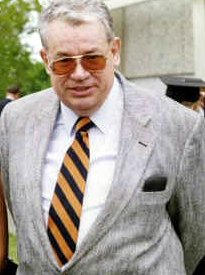Early life
Bill's early years were spent traveling around the world with his father, Michael, a U.S. Army soldier. His early interests included Rocketry, space exploration, and flying. This may have been due to his stepmother, Betty Lou Miller, being a Westinghouse clean-room supervisor. From an early age, she began putting electronics kits, books on space and satellites and other science related items in his room. Bill built his first radio at age 9 from one of the kits Betty had provided.
Bill's first contact with a computer came in 1976 through a copy of Creative Computing, a popular hobbyist magazine at the time. When Bill moved to Germany with his father in 1977, the school had a DEC PDP/11-4 series computer which had several teletypes attached. This is where his true talents came through. By 1979, Bill was spending more than 5 hours a day in the computer labs at Nuremberg American H.S., working on anything computer related he could. Always seen with his box of computer tapes, it was apparent that this would be his life.
In 1980, Bill returned to the US and once again turned to the computers and by summer of 1981, was working for Apple Pugetsound Program Library Exchange.
A.P.P.L.E.
Bill joined A.P.P.L.E in Summer 1981. Under the expert tutelage of Michael Christensen and Joff Morgan, Bill began to take an interest in Pascal which was fast becoming the programming language of the modern programmer. In January 1982, Bill began work on the Pascal Anthology which became a mainstay product for A.P.P.L.E until 1988. In 1989, he moved to Japan to pursue his career in engineering. His first job in Japan was working for a Japanese electronics house designing and programming satellite transceivers for ships.
In 1985 he created a language which allowed formatting of text and allowed user interaction. File Control Language was only released in small numbers and was soon made obsolete by the introduction of HyperCard. The other thing which led to the quick demise of File Control Language was the fact that it was oriented around the Apple II Series computers and was not ported to any of the other computing platforms of the era.
In 1997, he invented the self producing web system for computer databases, The Library 1.1. This system was a mainstay of the MSCOM software library which has become the surviving system in A.P.P.L.E's efforts to create one of the largest Apple related software and documentation libraries on the internet today.
In 2001, he began to work on restoring A.P.P.L.E and Call-A.P.P.L.E. Magazine. By May 2002, this was a reality with the first newsletter/magazine issue since 1994. Today, the magazine has a distribution of about 14,000 copies per month and continues to enjoy a high percentage of readers who are Apple II specific readers. Bill currently serves as the President of A.P.P.L.E. and is in his second term as President separated by a one-year period in which Mike Pfaiffer was President.

Pascal is an imperative and procedural programming language, designed by Niklaus Wirth as a small, efficient language intended to encourage good programming practices using structured programming and data structuring. It is named in honour of the French mathematician, philosopher and physicist Blaise Pascal.

UCSD Pascal is a Pascal programming language system that runs on the UCSD p-System, a portable, highly machine-independent operating system. UCSD Pascal was first released in 1977. It was developed at the University of California, San Diego (UCSD).
Turbo Pascal is a software development system that includes a compiler and an integrated development environment (IDE) for the Pascal programming language running on CP/M, CP/M-86, and DOS. It was originally developed by Anders Hejlsberg at Borland, and was notable for its extremely fast compiling times. Turbo Pascal, and the later but similar Turbo C, made Borland a leader in PC-based development.

The Altair 8800 is a microcomputer designed in 1974 by MITS and based on the Intel 8080 CPU. Interest grew quickly after it was featured on the cover of the January 1975 issue of Popular Electronics and was sold by mail order through advertisements there, in Radio-Electronics, and in other hobbyist magazines. The Altair is widely recognized as the spark that ignited the microcomputer revolution as the first commercially successful personal computer. The computer bus designed for the Altair was to become a de facto standard in the form of the S-100 bus, and the first programming language for the machine was Microsoft's founding product, Altair BASIC.

Southwest Technical Products Corporation, or SWTPC, was an American producer of electronic kits, and later complete computer systems. It was incorporated in 1967 in San Antonio, Texas, succeeding the Daniel E. Meyer Company. In 1990, SWTPC became Point Systems, before ceasing a few years later.
The Open Letter to Hobbyists is a 1976 open letter written by Bill Gates, the co-founder of Microsoft, to early personal computer hobbyists, in which Gates expresses dismay at the rampant software piracy taking place in the hobbyist community, particularly with regard to his company's software.

Carl Sassenrath is an architect of operating systems and computer languages. He brought multitasking to personal computers in 1985 with the creation of the Amiga Computer operating system kernel, and he is the designer of the REBOL computer language, REBOL/IOS collaboration environment, the Safeworlds AltME private messaging system, and other products. Carl is currently a Principal Engineer at Roku, Inc.

Retrocomputing is the use of older computer hardware and software in modern times. Retrocomputing is usually classed as a hobby and recreation rather than a practical application of technology; enthusiasts often collect rare and valuable hardware and software for sentimental reasons. However, some do make use of it.
Micro Instrumentation and Telemetry Systems (MITS) was an American electronics company founded in Albuquerque, New Mexico that began manufacturing electronic calculators in 1971 and personal computers in 1975.

Lawrence Gordon Tesler was an American computer scientist who worked in the field of human–computer interaction. Tesler worked at Xerox PARC, Apple, Amazon, and Yahoo!

Per Brinch Hansen was a Danish-American computer scientist known for his work in operating systems, concurrent programming and parallel and distributed computing.

Compute!, often stylized as COMPUTE!, was an American home computer magazine that was published from 1979 to 1994. Its origins can be traced to 1978 in Len Lindsay's PET Gazette, one of the first magazines for the Commodore PET computer. In its 1980s heyday Compute! covered all major platforms, and several single-platform spinoffs of the magazine were launched. The most successful of these was Compute!'s Gazette, which catered to VIC-20 and Commodore 64 computer users.

Creative Computing was one of the earliest magazines covering the microcomputer revolution. Published from October 1974 until December 1985, the magazine covered the spectrum of hobbyist/home/personal computing in a more accessible format than the rather technically oriented Byte.

Henry EdwardRoberts was an American engineer, entrepreneur and medical doctor who invented the first commercially successful personal computer in 1974. He is most often known as "the father of the personal computer." He founded Micro Instrumentation and Telemetry Systems (MITS) in 1970 to sell electronics kits to model rocketry hobbyists, but the first successful product was an electronic calculator kit that was featured on the cover of the November 1971 issue of Popular Electronics. The calculators were very successful and sales topped one million dollars in 1973. A brutal calculator price war left the company deeply in debt by 1974. Roberts then developed the Altair 8800 personal computer that used the new Intel 8080 microprocessor. This was featured on the cover of the January 1975 issue of Popular Electronics, and hobbyists flooded MITS with orders for this $397 computer kit.
The Apple Pugetsound Program Library Exchange (A.P.P.L.E.) is a users' group established in 1978 by Val Golding.

The history of the personal computer as a mass-market consumer electronic device began with the microcomputer revolution of the 1970s. A personal computer is one intended for interactive individual use, as opposed to a mainframe computer where the end user's requests are filtered through operating staff, or a time-sharing system in which one large processor is shared by many individuals. After the development of the microprocessor, individual personal computers were low enough in cost that they eventually became affordable consumer goods. Early personal computers – generally called microcomputers – were sold often in electronic kit form and in limited numbers, and were of interest mostly to hobbyists and technicians.

Home computers were a class of microcomputers that entered the market in 1977 and became common during the 1980s. They were marketed to consumers as affordable and accessible computers that, for the first time, were intended for the use of a single nontechnical user. These computers were a distinct market segment that typically cost much less than business, scientific or engineering-oriented computers of the time such as those running CP/M or the IBM PC, and were generally less powerful in terms of memory and expandability. However, a home computer often had better graphics and sound than contemporary business computers. Their most common uses were playing video games, but they were also regularly used for word processing and programming.

Software is a set of programmed instructions stored in the memory of stored-program digital computers for execution by the processor. Software is a recent development in human history, and it is fundamental to the Information Age.












